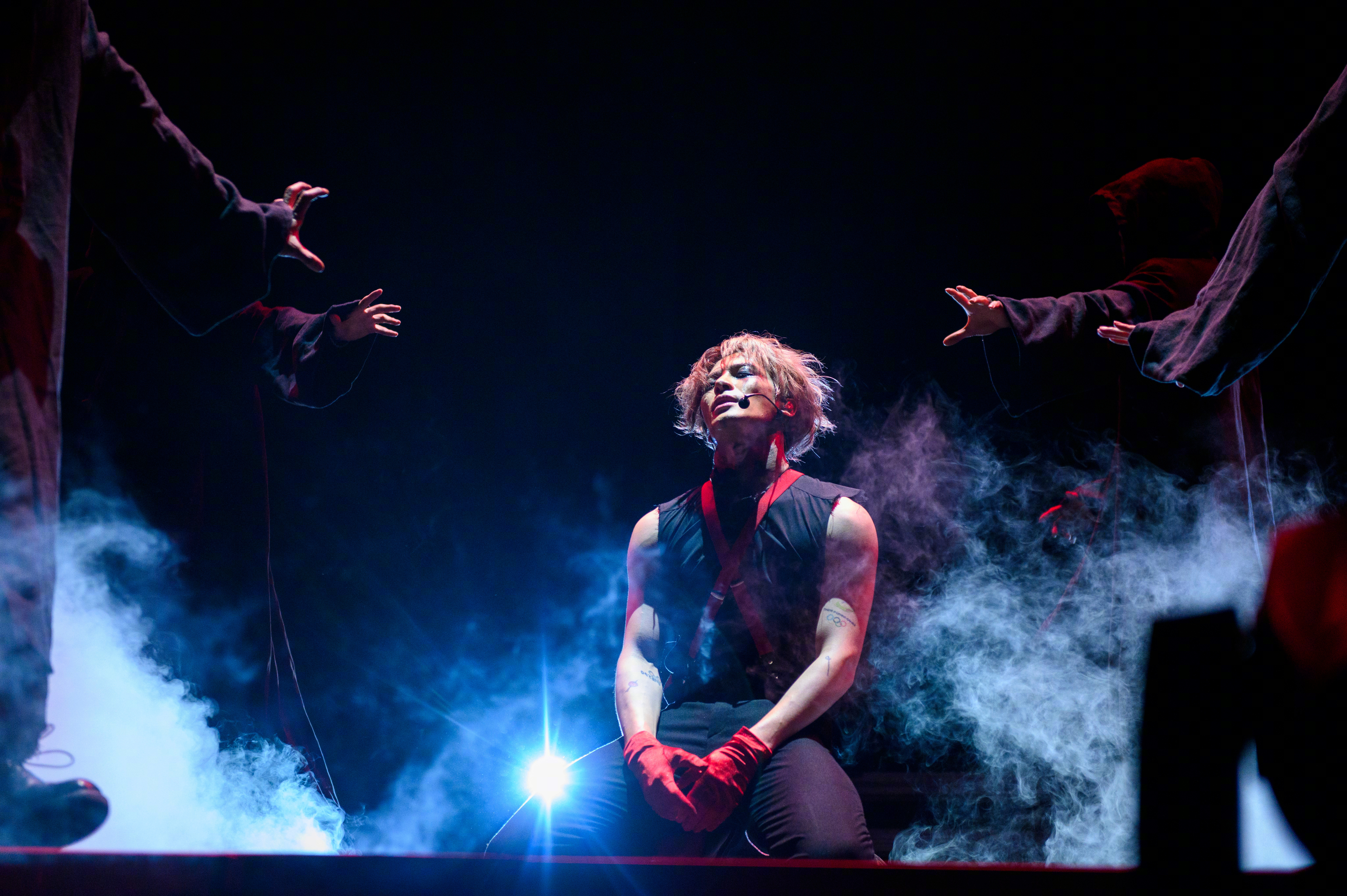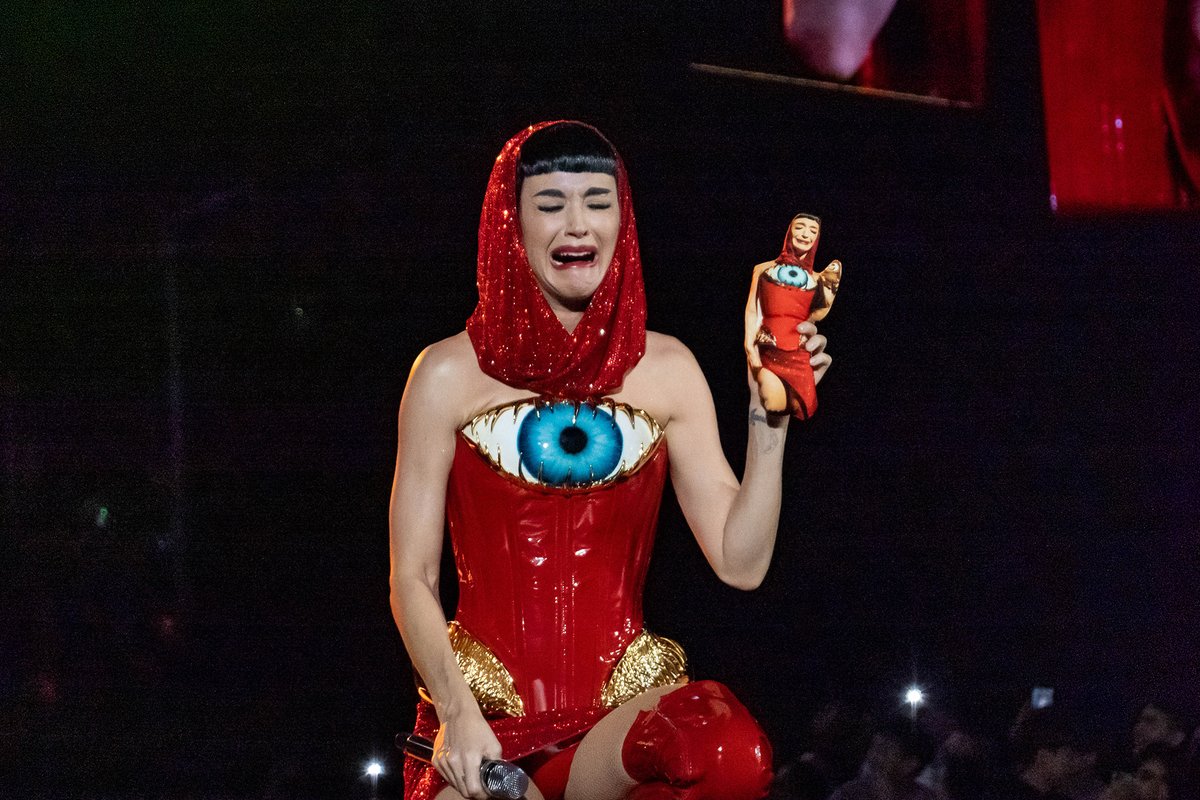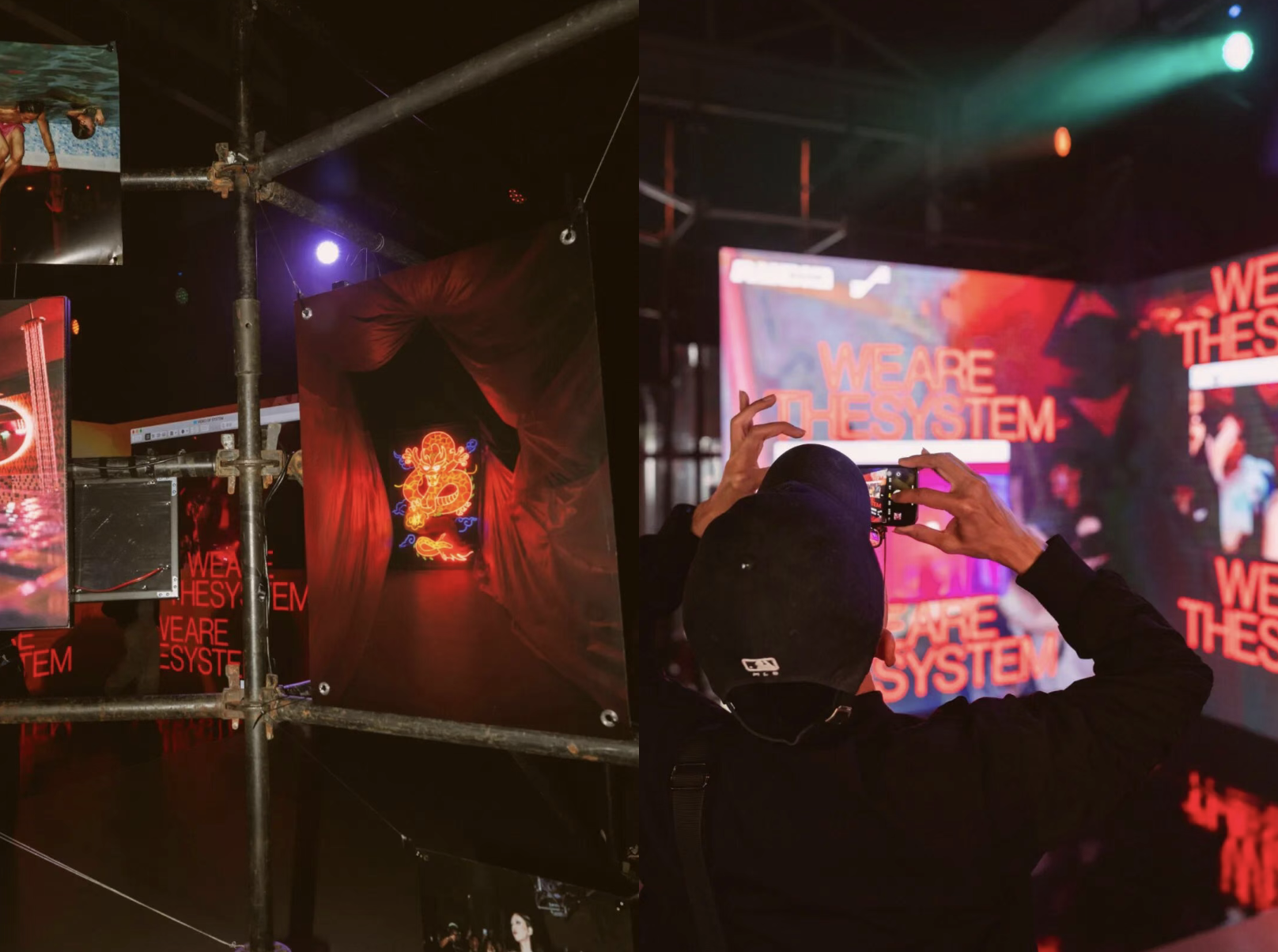We first met MC Tingbudong in 2018, when the NYC-based rapper and multimedia storyteller was nearing the end of a two-month residency called Found Sound China that saw him making beats and writing rhymes across rural Yunnan province, Chengdu, Shanghai and Beijing. We invited him out to LA last year for RADII’s sold-out china.wav live music showcase, and have kept tabs as Tingbudong has plugged in with other artists in the RADII sphere of coverage.
Now he’s back with “Runaway,” a new track and VR music video that takes viewers on a dizzying journey through the Chinese hip hop underground through the eyes of Tingbudong:
From night markets in Taiwan to rural farmlands in Yunnan, back alleys in Shanghai to studios and backstages in Beijing, the video takes viewers on a glitched-out trip through China’s underground music scene. The video takes a bootleg Ready Player One filter, complete with blue screen error crashes and fourth wall breaks. Featuring cameos from established and emerging Chinese generation Z artists, the video profiles the artist’s journey through a state-department funded music diplomacy program in 2018 and solo independent tour in 2019.

MC Tingbudong — aka Jamel Mims — launched the project with a multimedia exhibition at Canal street exhibition space Wallplay that combined Mims’ own creative and archival work (he did a Fulbright research project on the Beijing hip hop scene in 2008-2009) with work by similarly tuned artists and collectives such as 18 Uppercut, WY Huang, and from Kai Luen Liang.
The “Runaway” video is now out as a standalone release. Watch it below, and read on for a quick check-in with the peripatetic, bilingual rapper about his goal of “connecting Chinese hip hop to black, brown and asian communities in Chinatown NYC” with this project:
RADII: With Runaway‘s initial exhibition you had the “goal of connecting Chinese hip hop to black, brown and asian communities in Chinatown NYC during Chinese New Year.” How successful were you in this? What story does Chinese hip hop have to tell in a place as multicultural as NYC?
Runaway Chinese Hip Hop New Year was an attempt to bring these communities together through the vehicle of hip hop and youth culture. The theme of the exhibition was the past, present and future of China’s underground music scene — highlighting the past in the golden age of hip hop in China with The Misadventures of MC Tingbudong, the present with Runaway, a VR journey through China’s underground music scene, and the future as interpreted by multimedia work from artists WY Huang, Kai Luen and 18 Uppercut.
Related:
 Yin: Tap in to an Alternate Futurism with W.Y. Huang’s “Mercy”“A vision of the future through a spiritual Asian lens”Article May 10, 2019
Yin: Tap in to an Alternate Futurism with W.Y. Huang’s “Mercy”“A vision of the future through a spiritual Asian lens”Article May 10, 2019
 A Decade of Sound from Jeff Kai-Luen Liang, aka Soulspeak (Exclusive Mix)The formerly Beijing-based beatsmith also known as Soulspeak digs in to his archives for some choice cuts from his studio ca. 2010-2019Article Apr 10, 2019
A Decade of Sound from Jeff Kai-Luen Liang, aka Soulspeak (Exclusive Mix)The formerly Beijing-based beatsmith also known as Soulspeak digs in to his archives for some choice cuts from his studio ca. 2010-2019Article Apr 10, 2019
 Creative Collective 18 Uppercut Returns with Culture-Jamming Kung Fu Mashup “Dukkha”US/China/Singapore collective 18 Uppercut is back with another “synapse-slamming music video” with cultural references ranging from kaiju to kung fu, HK arthouse film to Jin Yong novelsArticle Dec 06, 2018
Creative Collective 18 Uppercut Returns with Culture-Jamming Kung Fu Mashup “Dukkha”US/China/Singapore collective 18 Uppercut is back with another “synapse-slamming music video” with cultural references ranging from kaiju to kung fu, HK arthouse film to Jin Yong novelsArticle Dec 06, 2018
With daily programming, the exhibition brought into space the sound, vibrancy and diversity of New York City: there were packed houses at the opening and closing parties, and a class visit from NYU’s Interactive & Digital Media Program, which included a number of native Chinese first-year students familiar with the artists on the walls. In the midst of the coronavirus and cloud party phenomenon in China, we hosted a Chinatown Cypher, a live recording for Shanghai Community Radio featuring bilingual rappers live from NYC.
The exhibition concluded with panel discussion that joined RADII social media strategist Kevin Hsia, artist WY Huang, 18 Uppercut’s Pete Gibson, and Shanghai Community Radio’s Difan Xu in a discussion about the past, present and future of Chinese youth culture. From the art on the walls to the wide array of participants and programming in the space — the Runaway pop-up was successful in the goal of connecting Chinese hip hop to black and brown youth in NYC’s Chinatown.



Runaway VR multimedia exhibition @ WallPlay // NYC youth post up in the ‘living room’ at Runaway VR next to posters of artists from 2008 Beijing at Yugong Yishan
Overall, the Runaway pop-up told a story of internationalism and cultural connection that mirrored the diversity of New York City itself, bringing together an international community between youth culture in the mainland, overseas Chinese, and international youth culture.
Black and Latinx otakus and harajuku teenagers take selfies on the couch alongside Chinese students from NYU, or participate in virtual reality workshops; a Chinese immigrant who hadn’t returned to China since being in Tiananmen Square demonstrations swaps stories with graffiti writers from the Bronx and independent artists; Harrison, a rapper and b-boy who came through for the cypher, realized we met in Beijing over a decade ago at [now defunct live music venue] Yugong Yishan, and then later we both discover a younger version of himself in one of the pictures on the wall.
Though not explicitly political, by placing work from golden age and contemporary hip hop culture in China, it was both a tribute and a warning: chronicling the story of an evaporating underground culture and the commercial industry built in its wake, a story all too familiar for hip hop-era New Yorkers. It showed a vision of a multicultural society moving beyond the limitations of identity politics and national identity, blending culture in way that could seem bizarre in other places — but is right at home in NYC.


MC Tingbudong @ MTA Festival
On the flip side of that: China is an overwhelmingly ethnically homogenous place, but hip hop offers a chance to connect people of different ethnicities and nationalities via a shared cultural form. What were some highlights of your latest tour of China in terms of grassroots cultural exchange through music?
The [2019] Xiaoting Xiaotour was my first independent tour in China, and was really about creating a grassroots network of cultural exchange through hip hop. The entire tour was coordinated on WeChat, and it was wild because no two shows were in similar venues or by scale or style — [they ranged] from large-scale festivals, to house parties, to freestyle workshops and classes at the US Embassy, to online live recordings, to club sets in Chengdu, Beijing and Taiwan. Some highlights regarding cultural exchange:
-
MTA Festival: With massive crowds in the desert, headlined by Tinashe, Higher Brothers and Jay Park — it was a milestone to perform at a high level, and also a great opportunity to connect with with Generation Z artists like Young13dbaby, Lazysoul, #nineone, Lows0n and Mask-K, and to deal with the hip hop industry firsthand.
Related:
 Gen Z Rapper Lows0n: “I Started Learning Music in the Womb”The Fujian rapper discusses her singular visual+sonic style and her life’s mission of “communicating my spirit”Article Jun 04, 2019
Gen Z Rapper Lows0n: “I Started Learning Music in the Womb”The Fujian rapper discusses her singular visual+sonic style and her life’s mission of “communicating my spirit”Article Jun 04, 2019
-
Shanghai: After performing at a Stranger Things Season 3-esque mall with an indoor pool at LOFAS, connecting on the ground with the club scene at ALL and Elevator in Shanghai; inspiration from the international/future music scene; recording the first-ever live street studio performance for SHCR.
-
Guangzhou: The show in Guangzhou was an experimental interactive improvisational performance — imagine Sleep No More or a game of Mafia, but it takes place in a speakeasy in Guangzhou’s vintage district with death scenes and fights. I played a time-displaced MC Tingbudong hosting the speakeasy party, while Eddie Lu, who came on the tour as DJ and manager, would later get accused of withholding secrets, enter a breakdance battle, and meet an untimely end in a spectacular death scene. Definitely was a highlight to be doing experimental theater in Chinese, and was surprised at how receptive this audience was to the art form — and genuinely shocked how good an actor Eddie is.
-
Xi’an: In between performing in Chengdu and Shanghai, I took a train out to Xi’an to see Purple Soul, a group I haven’t seen perform since the days of crashing on the couch in north Beijing with [related rap trio] in3. It was deeply moving to see the growth and development of homies I knew from over a decade ago — seeing fans stretch out in lines around the block and pack out livehouses, knowing what the group, whose music was placed on the banned list by the government [in 2015], had to overcome to get there.
Related:
 “I’m a Hustler”: After Being Banned, Beijing Hip Hop OG Jahjah Way is Building a New Community“We used to be on the street, but now street culture is not on the street, it’s only on the screens. This is a problem.”Article Feb 26, 2020
“I’m a Hustler”: After Being Banned, Beijing Hip Hop OG Jahjah Way is Building a New Community“We used to be on the street, but now street culture is not on the street, it’s only on the screens. This is a problem.”Article Feb 26, 2020
-
Freestyle Workshops + Classes: At NYU Shanghai and in Guangzhou, I began a workshop and lecture series on the the history of hip hop culture and its parallels to the development of Chinese hip hop, and the art of freestyle rapping. From a cultural exchange perspective, this was a major highlight — giving young Chinese artists a sense of history and agency within a global subculture, and directly connecting with students and young artists in China.
My overall takeaway so far was definitely the broad and deep appeal of hip hop culture — as well as the importance of very consciously cultivating the right audience; some of the best shows weren’t necessarily the most full, but ones with the right audience, where the avenues for cultural exchange were open. Find out more highlights, stories, and lessons learned on the Misadventures of MC Tingbudong, Season 2!

Students from NYU’s IDM program

@cyberamaris + @sabel_boo by the hip hop wall
I know you’ve worked with VR quite a bit before. What about this format is appealing to you and why did you choose it as the medium for Runaway?
As a medium, VR is an incredibly immersive format. It makes me think how people who saw the first moving images felt after only seeing photographs. However, while there is a lot of VR content nowadays, lots of it rendered in CGI and produced for high aesthetic value, to have you on the moon or in the Great Barrier Reef or the Great Wall. I began to wonder: what would it be like to put this storytelling device in the hands of people from historically marginalized communities? What if you could use this medium to immerse people in the memories of others? My approach to VR became to use the medium to immerse viewers in the experiences of others to drive empathy, to use virtual reality to make you take action in reality.
I knew that I wanted to produce another virtual reality video after releasing “Hands Up” back in 2017, and since then I’ve made a practice of carrying my 360 camera with me everywhere I went. The original concept was to have the video span a series of locations around the world, but after a hard drive failure, I had to keep the footage relegated to China. The song, originally a freestyle recorded at a Found Sound Nation street studio in Brooklyn, was inspired by how immigrants are pushed and pulled by a global system of exploitation, especially at the US southern border.
I knew I wanted something that gave you this feeling, and threw you headfirst into somewhat alienating scenarios and foreign encounters, but wanted it to be more than a travelogue or series of random clips. It needed a narrative. And so the idea came to create a storyline of playing back through memories, but in the style of immersive video game, complete with blue-screen errors and fourth-wall breaks that occur when sharing a memory or retelling a story.

Runaway VR video still featuring Gen Z rappers Shining, Erioe, and Lows0n at MTA Space
What are you working on for the rest of the year/beyond? Any further China-related plans?
I’m planning for 2020 to be a big year in terms of releasing music and forging a global community, building on my work over the past two years from the Found Sound China residency in 2018, the Xiaoting Xiaotour in 2019, and the Runaway VR Chinese Hip Hop New Year Pop Up in 2020.
Runaway is the first release in a series of monthly projects leading to the release of my first Mandarin-language EP this spring, so expect monthly music video and single releases, including a crazy new video shot by RADII’s very own Dawei Chen dropping next month, and an OD kawaii video project featuring Eddie Lu + Kayla Briet after that. On the performance side, I’ll be on tour this May with LA-based bilingual hip hop group NiteMrkt for their Family Special Tour on the east coast, and plan to release the EP before returning to China for a tour in late summer/fall 2020.
More on MC Tingbudong:
 MC Tingbudong Wants Chinese Hip Hop to Find its Place in the World“I felt like I was like being offered the chance to participate in the era of hip hop I had so revered during my upbringing”Article Feb 11, 2019
MC Tingbudong Wants Chinese Hip Hop to Find its Place in the World“I felt like I was like being offered the chance to participate in the era of hip hop I had so revered during my upbringing”Article Feb 11, 2019

















